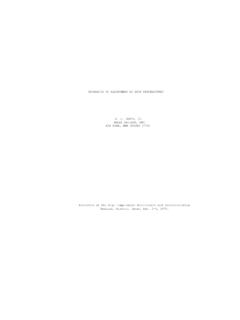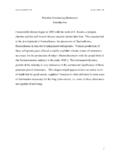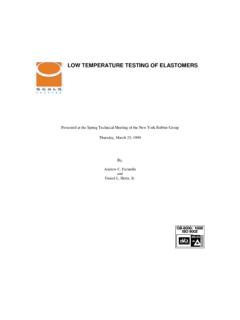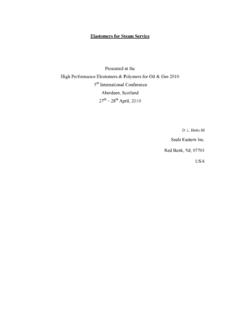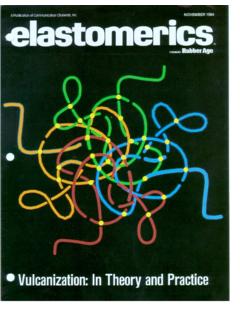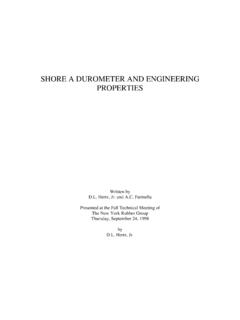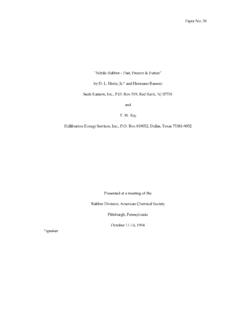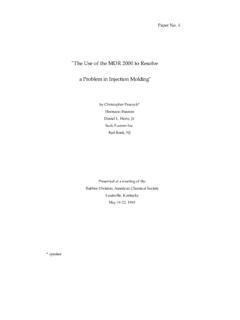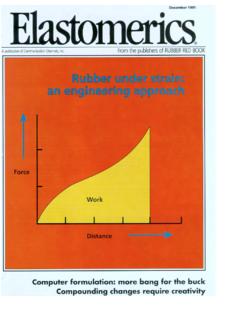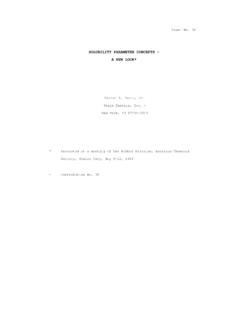Transcription of HNBR in CO2 - Rubber Seals, Orings, Gaskets, and …
1 hnbr in CO2 Presented at the High Performance Elastomers & Polymers for Oil & Gas 2014 International Conference Edinburgh, SCO, UK 15 - 16th April, 2014 D. L. Hertz III Seals Eastern Inc. Red Bank, NJ, 07701 USA 2 ABSTRACT Nitrile Rubber ( NBR ) remains one of the most popular oilfield elastomers. More recently, hydrogenated nitrile Rubber ( hnbr ) is being accepted in its place on account of its similar toughness and improved stability in the presence of heat and reactive chemical species. However, carbon dioxide (a naturally occurring gas that is frequently encountered in hydrocarbon environments) presents challenges for the NBR class of polymers. Relatively small concentrations of CO2 in hydrocarbon mixtures can cause significant seal swelling if consideration is not given to the specific choice of polymer, cure, and elastomer reinforcement.
2 More significantly, the effect of absorbed CO2 upon rapid gas decompression can be catastrophic if the same consideration is not applied. This study explores the interaction of CO2 and hnbr polymers. The relationships between CO2 and acrylonitrile level is examined. This study is a continuation of work conducted and presented at RAPRA s 2012 High Performance and Specialty Elastomer symposia but with an exclusive focus on hnbr . The study s objective is to provide reference data for both the application engineer and compounder when designing for applications where CO2 will be encountered. INTRODUCTION Carbon Dioxide (CO2) is a naturally occurring colorless, odorless gas. It is frequently found in hydrocarbon reserves. CO2, in the gaseous state, is denser than air with a specific gravity of kg/m3. CO2 is a linear molecule of two oxygen atoms bonded to one carbon atom through double bonds (C=O=C).
3 The molecule is symmetrical around the carbon atom and thus has no dipole moment. However, CO2 being a linear triatomic molecule possesses four bending modes. The molecule presents symmetrical and unsymmetrical stretch modes. The third and fourth bending modes include bending in the plane of page or perpendicular to it ( doubly degenerate ). Given the CO2 s transient dipole moments, the molecule appears benti ( like an H2O molecule). Thus, the simple rule of thumb of likes dissolves likes is misleading if you consider CO2 as a linear molecule. Carbon dioxide becomes a supercritical fluid and hence a solvent at relatively modest pressures and temperatures. The requisite parameters frequently exist in the reservoir and production conditions. Carbon dioxide is only able to exist in the liquid state at pressures above MPa ( PSI).
4 The triple pointii of CO2 is about .518 MPa ( PSI) at C. The critical pointiii is MPa ( PSI) at C (88 F).iv In the course of this study, super-critical conditions were not present. The solvating powers of CO2 are well documented and applications utilizing supercritical CO2 have been established for some time now. Unfortunately for the oil & gas field operator, these very same principles are at work sabotaging elastomeric seals and the equipment they are designed to serve when CO2 is present in the hydrocarbon stream. Modest amounts of CO2 present in the hydrocarbon reservoir can induce failure in elastomeric seals that otherwise perform admirably in high pressure gases. Usually, the damage occurs during rapid gas depressurization ( RGD ). This study was conducted using 5 MPa (750 PSI) of pure CO2 which could be considered moderate pressure in terms of most field conditions.
5 However, the implications of Dalton s Law of Partial Pressures should be considered when viewing this data. Specifically, Dalton postulated that the total pressure of a mixture of gases is just the sum of the pressures that each gas would exert if it were present alone and occupied the same volume as the mixture of gases. Under most conditions, the molar fraction of CO2 in a hydrocarbon gas mixture is substantially smaller than the molar fraction of the other gases present ( N2, He, O2, CH4, C2H6, C3H8, etc.). Thus, in the context of partial pressure, the CO2 condition in this study would exist in well pressures of several thousand 3 PSI where the CO2 molar fraction is only a few percentage points. On the other hand, in a situation such as CO2 reinjection, field results might differ substantially from those observed herein.
6 For a more critical discussion of the theoretical dynamics and associated references, the author directs you to the published article Elastomers in the Hot Sour Gas Environment by Hertz, This study was undertaken to document hnbr s interaction with CO2. hnbr is a copolymer of acrylonitrile ( ACN ) and Butadiene. Unlike NBR, the copolymer is subsequently hydrogenated to increase saturation of the butadiene component. NBR and hnbr are primarily graded by their acrylonitrile content. By varying the ratio of ACN and butadiene, different properties are obtained. How this ratio affects hnbr behavior in CO2 was the question addressed by this study. OBJECTIVES The first objective of this study was to offer a comparative analysis of various hnbr grade s swelling in pressurized CO2 and swelling subsequent to rapid gas decompression ( RGD ).
7 The enclosed data might then serve as a quick reference for determining possible swelling of hnbr compounds in reservoirs known to contain CO2. The second objective was to offer details that could mitigate/exacerbate the swelling of hnbr compounds subject to CO2 either while under pressure or subsequent to RGD. Specifically, this study examined differences attributable to the amount of acrylonitrile, the amount of curative, grades of fine particle reinforcement, and the amount of fine particle black. SCOPE CONTROLLED FACTORS: Elastic modulus is a primary consideration of seal design. It is also one attribute affecting an elastomer s behavior under pressure and during RGD. However, there are several factors that will ultimately define elastic modulus as well as other material attributes.
8 An experimental array would be unwieldy if all these factors and their possible levels were all examined. For purposes of this experiment, the author chose only the most fundamental factors used to develop elastic modulus and solubility behavior of an hnbr oilfield compound. A Taguchi L9 Orthogonal Arrays was used to study the factors and their associated levels. Specifically, the controlled factors were: 1) The Acrylonitrile content; 2) The degree of cross-linking as controlled by part-per-hundred ( phr ) of curative; 3) The particle size/structure of carbon black, controlled by grade of carbon black, specifically N990, N762, and N330; 4) The loading of carbon black reinforcement, controlled by phr of carbon black. ENVIRONMENT: Gas composition and testing temperature, while constant, were treated as uncontrolled factors in the experiment.
9 A pressure vessel, with a built in observation window, per Figure 1B, was flushed and charged with a connected canister of pure CO2 at room temperature C (73 F) to evaluate the specimens placed within it. The configuration is schematically detailed in Figure 1A. 4 Figure 1A Test Fixture Configuration Figure 1B Observation Vessel and test vials ELASTOMERS: For the Rubber compounder and application engineer, hnbr polymer is normally graded on the following attributes: 1) Percentage content of acrylonitrile, 2) Degree of saturated butadiene in the backbone, 3) Mooney viscosity. This is not an exhaustive list of attributes, but those most indicative of the materials behavior. This study focused primarily on the acrylonitrile content while attempting to hold the other attributes constant.
10 Because the acrylonitrile content primarily defines the molecular composition of hnbr and its resistance to non-polar ( hydrocarbons) and polar ( water) substances, it was the primary focus of this study. All of the hnbr compounds herein were mixed on an open 12-inch roll mill. hnbr code Median Percent Acrylonitrile (%) Median Percent Saturation (%) Median Mooney Viscosity 1010 44% 96% 85 2010 36% 96% 85 3310 25% 95% 80 4310 17% 95% 72 Table 1 Elastomer Test Groups and Specimens 5 TEST SPECIMENS: Specimens conforming to those defined by ASTM D1460-86 (2010) Section were utilized. The specimens were die cut from ASTM slabs and measured 100 mm ( in.) in length by ~ mm ( in.) wide by ~ mm ( in.) thick. By so doing, the author could make reliance upon Table 1 of ASTM D1460-86 (2010) for approximating the percentage change in volumevi.
